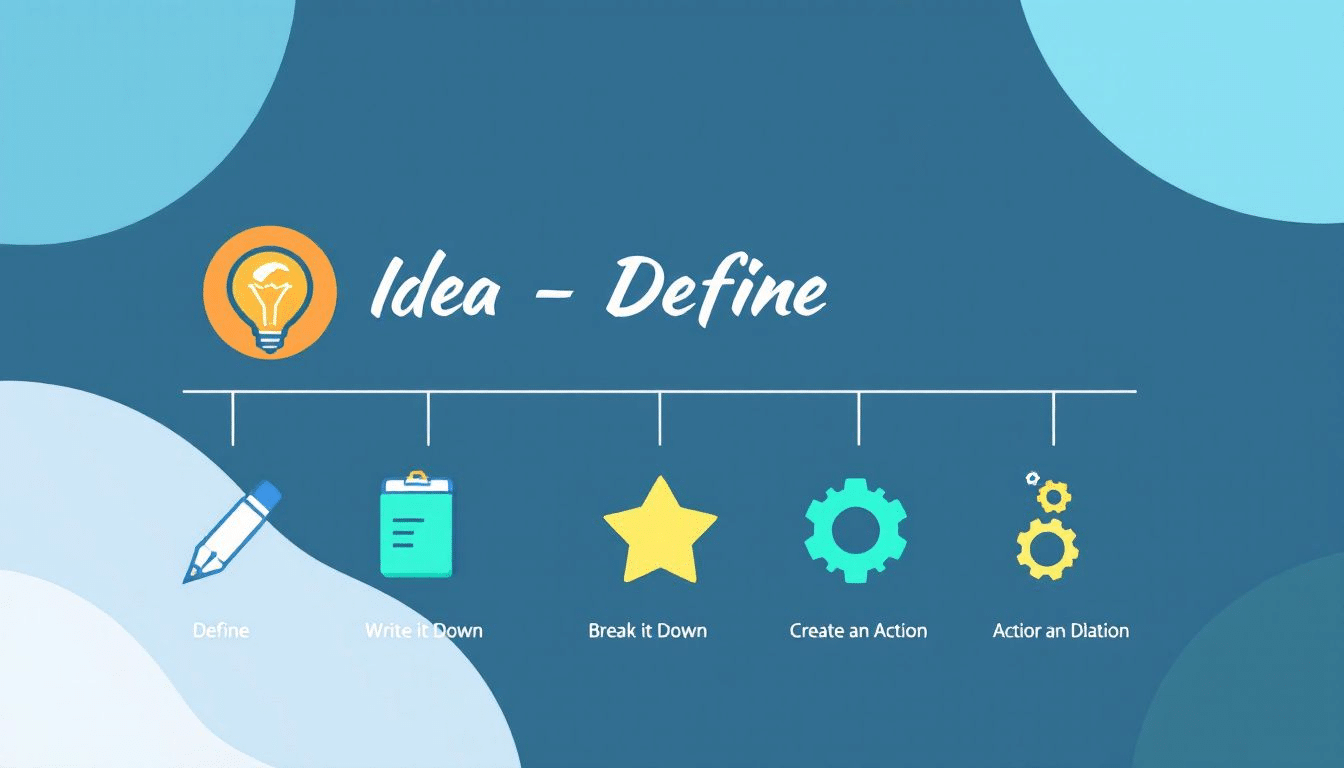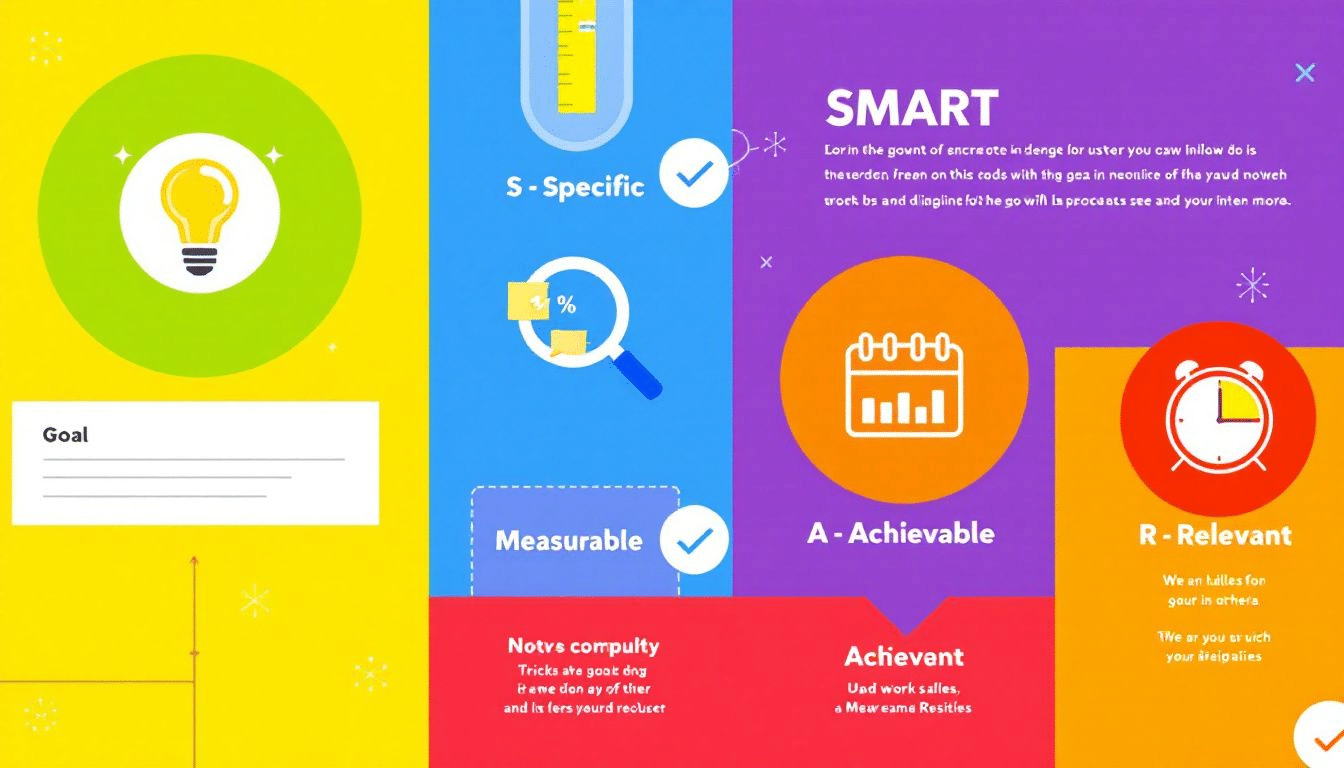Achieving your dreams starts with setting clear, actionable goals. This guide to setting goals will walk you through the steps to identify your objectives, create a concrete plan, and stay motivated until you succeed. Expect to learn about the SMART framework, breaking down long-term goals, and creating a detailed action plan.
Key Takeaways
Set specific, measurable goals using the SMART framework to enhance clarity and motivation.
Break down long-term goals into manageable steps to simplify your journey and maintain consistent progress.
Regularly review and adjust your goals to align with your values and ensure continued motivation and success.
Understanding Goal Setting

Goal setting is about identifying your aims and establishing measurable, specific objectives to achieve them. It’s not merely about vague plans but about creating a clear path to your dreams. Clear goals help manage measurable outcomes, leading to improvement.
Goals provide direction, focusing your efforts, time, and resources on your desired outcomes. Without them, your purpose remains a dream, unfulfilled. Think of goals as a compass, guiding you through life and keeping you on track despite distractions.
The psychological benefits of goal setting are significant, helping individuals find greater meaning, stay focused, and be disciplined. Setting goals commits you to continuous improvement and self-discipline, transforming your life to be more resilient and purpose-driven.
The goal setting theory, which explains how goals influence behavior, highlights the importance of setting challenging and specific goals to boost performance and motivation. Understanding and applying this theory can help you set goals that inspire and drive you to achieve them.
The Importance of Specific Goals
Specific goals are vital as they provide a clear path to achievement, guiding your focus and maintaining motivation. Research shows specific and challenging professional goals significantly enhance performance compared to vague objectives. Clear goals make it easier to stay committed and focused.
For instance, instead of setting a general goal like “lose weight,” a specific goal would be “lose 40 pounds by the end of the year.” This clarity helps you tailor your actions and efforts towards achieving that precise target. Other examples include saving half a million dollars by age 50 or writing a book by the end of the year. These specific goals provide a roadmap that guides your daily actions and decisions.
Specific goals can lead to increased effort and persistence as actions are tailored to the presented challenges. Knowing what you want to achieve makes it more likely to put in the necessary effort and remain persistent, which is key to overcoming challenges and making consistent progress toward your outcome goal and desired outcome.
Specificity in goal setting helps break down goals into manageable tasks, making it easier to track progress and celebrate achievements. Setting specific goals aligns your efforts with desired outcomes, setting you up for success.
SMART Goals: A Framework for Success

The SMART framework—Specific, Measurable, Achievable, Relevant, and Time-bound—is a powerful tool for effective goal setting, ensuring your goals are clear, realistic, and actionable, providing a solid foundation for success.
Specific goals enhance clarity and motivation. Knowing exactly what you need to achieve makes it easier to stay focused. For instance, instead of saying “I want to save money,” a specific financial goals would be “I aim to save $10,000 in the next six months.”
Measurable goals are crucial for tracking progress, enhancing motivation by showing how far you’ve come and how close you are to your end goal. Using KPIs (Key Performance Indicators) or OKRs (Objectives and Key Results) to measure progress helps you stay on track and make necessary adjustments.
Achievable goals are key to maintaining motivation. Unrealistic goals can lead to frustration and burnout, while attainable goals keep you motivated and focused. Realistic goals should be challenging yet attainable, promoting growth without overwhelming you.
Relevant goals align with your values and long-term objectives, directing your efforts towards meaningful goals. When your goals resonate with your values, you’re more likely to stay motivated and dedicated.
Time-bound goals create urgency and accountability. Deadlines ensure focus and commitment, whether it’s a short-term goal like “exercise three times a week for the next month” or a long-term goal like “write a book within a year.” Timelines help you stay on track and measure progress.
Breaking Down Long-Term Goals
Long-term goals can seem daunting, but breaking them down into smaller, manageable steps makes them more achievable. Start by clearly defining your ultimate goal, which allows you to create a roadmap for getting there.
A step-by-step plan simplifies the journey towards complex goals. Begin with a five-year plan, then break it down into a one-year plan, a six-month plan, a one-month plan, and a daily To-Do List. This approach ensures consistent progress towards your long-term objectives.
Identifying key milestones marks significant progress toward your main goal, acting as checkpoints to celebrate small wins and stay motivated. For example, key milestones for writing a book could include completing an outline, writing the first draft, and submitting the manuscript to a publisher.
Creating sub-goals involves breaking down milestones into smaller, manageable objectives. List specific tasks for each sub-goal to define actionable steps. For example, if your milestone is to write the first draft of your book, sub-goals could include writing a certain number of pages each week.
Prioritizing tasks based on their impact ensures focus on what will most effectively lead to goal achievement. Determine the most important tasks and tackle them first, helping you stay organized and focused on your journey while considering task complexity.
Breaking down ambitious goals maintains motivation and ensures attainable progress. Achieving goals allows for celebrating small wins, which boosts motivation and keeps you engaged. By taking one step at a time, the journey to your ultimate goal becomes more manageable and rewarding.
Creating an Action Plan

Creating an action plan is critical in goal setting. The first step in backward goal setting is to determine your end goal, allowing you to map out a clear path. Using the SMART framework helps establish clear, attainable goals by defining parameters like timeline and measurement.
Mapping out a timeline includes outlining tasks, milestones, and deadlines. An action plan details specific tasks needed to achieve defined goals. For example, if your goal is to write a book, your action plan might include researching, drafting chapters, and editing.
Monitoring and revising your action plan ensures careful consideration for adaptability to changing priorities or situations. Life is unpredictable, and goals may need adjustments. Regularly reviewing your plan allows for necessary changes to stay on track.
Prioritizing tasks helps teams understand which actions to complete first and identify dependencies. Setting deadlines and milestones motivates team members by clarifying their contributions to larger goals. This prioritization is essential for staying organized and focusing on key tasks.
Emphasizing daily habits is crucial in creating a plan for goal attainment. Identifying daily, weekly, and monthly goalposts breaks down the overall goal into manageable parts. A to-do list and checking off each step enhances the sense of accomplishment, and focusing on small, daily actions ensures steady progress towards larger goals.
Overcoming Potential Obstacles
Every journey to goal achievement will encounter obstacles. Common obstacles include resource shortages, unexpected life events, and the actions of others. Identifying potential barriers ahead of time allows for proactive strategies to overcome them.
Challenges during goal achievement may include knowledge deficits, interpersonal issues, and contextual factors. Mitigate obstacles by listing potential barriers and devising strategies to overcome them. For instance, if a project requires specific skills, consider taking a course to fill knowledge gaps.
The surrounding environment significantly affects goal achievement and motivation. Creating a conducive environment supports positive habit formation and reduces the impact of negative surroundings. For example, if trying to eat healthier, keep nutritious snacks at home and remove unhealthy options.
Recognizing small wins enhances resilience and fortifies your ability to overcome setbacks. Celebrating victories, no matter how minor, boosts confidence and keeps you motivated. Identifying misalignments in your goals compared to your values helps avoid frustration and confusion.
A clear and specific plan helps navigate obstacles more effectively. Learning from setbacks and adjusting your approach based on past experiences is crucial. Maintaining flexibility and staying committed to your goals allows you to overcome obstacles and continue making progress.
Staying Motivated and Consistent

Staying motivated and consistent is crucial for long-term success in achieving your goals. Setting inspiring and challenging goals maintains enthusiasm and momentum. Exciting goals make you more likely to stay committed and make consistent progress.
Goal setting stimulates new behaviors, maintaining motivation over time. A supportive network provides motivation and accountability, making it easier to achieve goals. Surround yourself with people who encourage and support your aspirations.
Methods like the PACT approach help maintain consistency in long-term goal progress. A clear timeline with deadlines enhances accountability and focus. Regularly evaluating your goal-setting process helps identify obstacles and improve strategies.
Documenting your goals enhances your chances of achieving them. Write down your goals and keep them visible as a reminder of what you want to achieve. Recognizing incremental progress is essential for maintaining momentum on the journey to significant objectives.
Acknowledging small successes enhances your mood and sustains motivation while working toward larger goals. Celebrating milestones creates a supportive environment, especially in teams, preventing burnout and promoting collective motivation.
By staying motivated and consistent, you can turn your goals into reality.
Celebrating Achievements

Celebrating achievements at various milestones enhances motivation and reinforces commitment to ongoing goals. Take time to enjoy the achievement and reflect on progress. This reflection helps appreciate how far you’ve come and motivates continued striving for future goals.
Celebrating achievements fosters a sense of purpose and can contribute to improved self-esteem and self-confidence. Whether it’s a small victory or a significant milestone, acknowledging your progress can boost your confidence and encourage you to keep pushing forward.
After achieving a goal, review the rest of your goal plans to ensure they are still relevant and aligned with your aspirations. The satisfaction of achieving your goals contributes to overall motivation and future success. It is important to reward yourself after achieving a significant goal, as it helps build self-confidence.
By celebrating your achievements, you reinforce the positive behaviors and habits that led to your success, setting the stage for continued progress and accomplishment.
Aligning Goals with Personal Values
Aligning your goals with your values and passions is essential for maintaining motivation and achieving satisfaction. When your goals resonate with what truly matters to you, you’re more likely to stay motivated and dedicated to achieving them.
Identifying core values is the first step in ensuring that your goals reflect what is important to you. Take time to reflect on your values and passions, and make sure your goals align with these principles. Regularly reviewing your goals helps maintain their alignment with your evolving values and passions.
Goals that reflect personal values promote greater enjoyment and fulfillment in the pursuit of achievements. Misaligned goals can lead to frustration and burnout, highlighting the importance of value alignment. Effective goal setting can enhance mental well-being and overall success.
By ensuring that your personal goals are aligned with your personal values, you create a sense of purpose and fulfillment that drives you to achieve your aspirations.
Measuring Progress and Adjusting Goals
Measuring progress and adjusting goals as needed is crucial for staying on track and achieving your desired outcomes. SMART goals eliminate vagueness, allowing for precise tracking of progress and timely identification of setbacks. Regularly tracking progress allows for adjustments and helps maintain motivation throughout the process.
Establishing specific goals allows for measurable and actionable tracking of progress. Evidence of progress motivates individuals in relation to their goals. By setting measurable goals, you can track your progress and celebrate your achievements along the way.
Regularly reviewing and updating your goals is essential to maintain progress in goal setting. Measuring results, effort, and time spent on important tasks helps track progress effectively. Setting time constraints within SMART goals ensures everyone is aligned on the goal’s timeline and accountability.
Adjusting goals accommodates life circumstances and is important for staying on track. Consider what’s working and what isn’t when reflecting on your goals. If your goals no longer hold any attraction, consider letting them go.
By regularly measuring progress and adjusting your goals, you can stay on track and ensure that your efforts are aligned with your desired outcomes.
Summary
In summary, effective goal setting is a powerful tool for achieving success in both personal and professional life. By understanding the fundamentals of goal setting, the importance of specificity, and the power of SMART goals, you can set clear, actionable goals that drive you towards your desired outcomes.
Following the steps outlined in this guide, from breaking down long-term goals to creating an action plan and overcoming obstacles, ensures that you stay motivated and on track. By celebrating your achievements and aligning your goals with your values, you create a fulfilling and purpose-driven journey towards success.
Now is the time to start setting and achieving your goals. Remember, the journey of a thousand miles begins with a single step. Take that step today and turn your dreams into reality.
FAQ
What is the SMART framework in goal setting?
The SMART framework is your key to effective goal setting, as it emphasizes making goals Specific, Measurable, Achievable, Relevant, and Time-bound. By following this approach, you’ll set clear and actionable targets that pave the way to your success!
How can I stay motivated while working towards my goals?
To stay motivated, set inspiring and challenging goals, surround yourself with supportive people, and celebrate your small wins along the way. Remember, every step forward is a reason to feel proud!
What should I do if I encounter obstacles in achieving my goals?
When you face obstacles in achieving your goals, proactively identify potential barriers and develop strategies to overcome them. Embrace setbacks as learning opportunities to refine your approach and keep moving forward!
Why is it important to align my goals with my personal values?
Aligning your goals with your personal values is essential because it fuels your passion and commitment, leading to a more fulfilling and motivating journey towards your achievements. When your goals reflect what truly matters to you, success feels even more rewarding.
How can I measure progress and adjust my goals effectively?
To effectively measure progress, regularly track your measurable goals and review them to see what’s working and what needs adjustment. Stay flexible and be willing to adapt your goals to align with your evolving circumstances for continued success!





